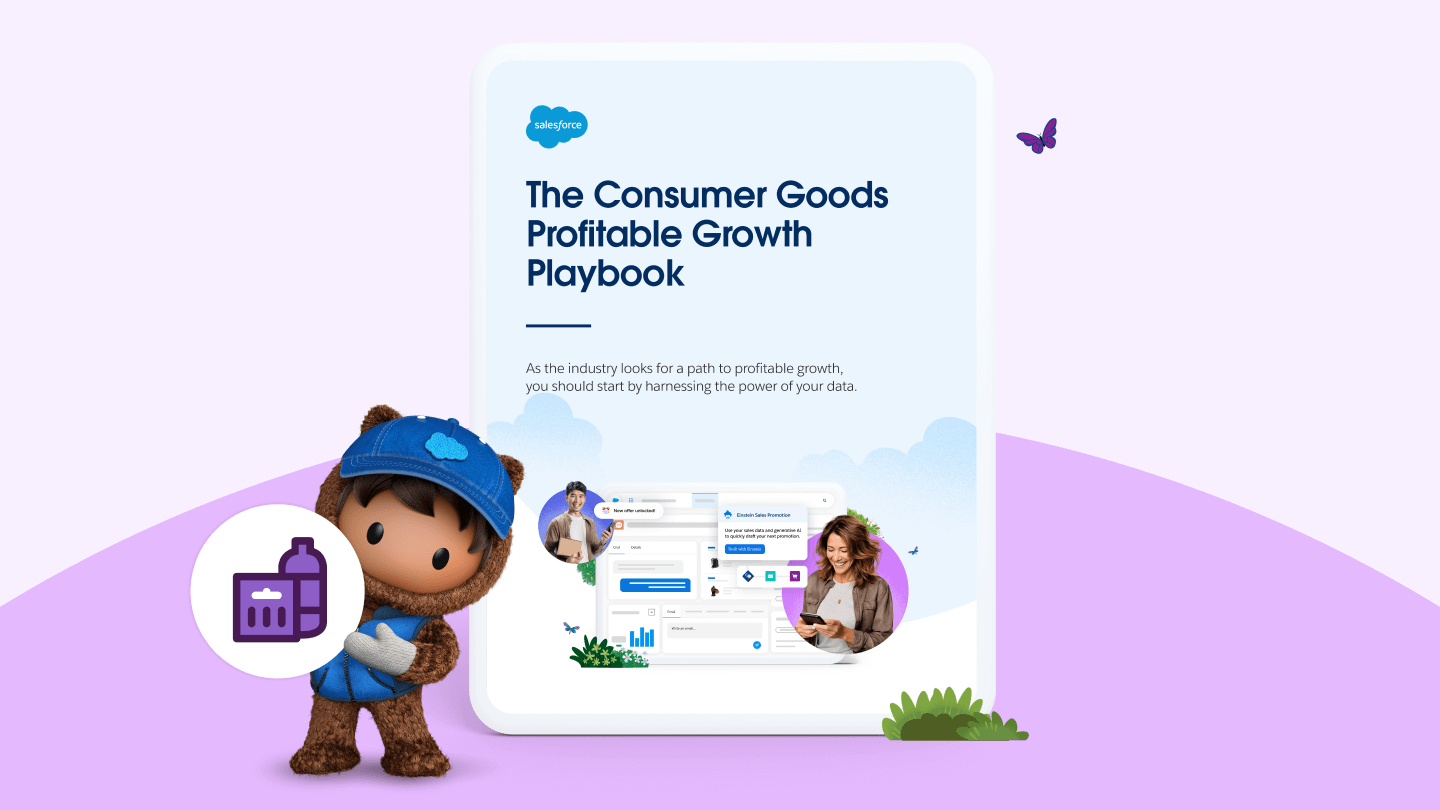What High-Performing Brands Know About Sales and Service

The lines between consumer goods sales and service reps are increasingly blurred. But when brands unify those teams and their data, they drive revenue and customer loyalty.
We hear a lot these days about the need for close alignment between sales and marketing teams. But for consumer goods (CG) brands, which are increasingly challenged to beat margins and achieve profitable growth, aligning sales and service can reap huge benefits.
It makes sense: Consumer goods sales and service teams both interact with customers, but often they do so separately. For example, when a large retailer’s order is cut, both departments should be notified. But in the traditional model, sales often plans orders in offline spreadsheets and fullfills them in a disparate platform. The result? Service doesn’t have visibility into the change until the customer calls them about the order.
Additionally, from the customer’s perspective, the line between sales and service increasingly blurs. Many customers will go to their account manager first if they have a service need. And now, customer service reps are expected to be both proactive and reactive sellers in their service interactions. So, it’s important that both teams reach beyond their traditional scope and are prepared to work together as one.
Data shows that reps at high-performing service organisations have much more visibility into customers’ sales, marketing, and service data, with 86% saying they have a complete and accessible view of customers’ sales and ecommerce interactions. More than one in four reps still lack that insight.
Ultimately, brands that successfully integrate their sales and service teams create a unified customer experience maximising customer retention, revenue, and satisfaction. So it’s surprising that only 4% of CG executives say their organisations have a fully realised omni-channel sales and service strategy. If you haven’t yet aligned your sales and service strategies, where should you start?
Consumer Goods Sales & Service
Optimise consumer goods sales and service collaboration
Aligning sales and services begins with putting the right tools and processes in place. These include an integrated CRM system, trusted data, and artificial intelligence (AI). More and more, AI plays a pivotal role in enhancing collaboration between sales and service teams by streamlining processes, providing actionable insights, and automating routine tasks. In fact, 79% of service organisations are investing in AI, with 83% of decision-makers planning to increase their investment in AI in the coming year. That’s good news, since our research shows that during an average week, service agents spend just 39% of their time working with customers. Automating their busywork with AI platforms and AI agents can help free them up for more high-value, proactive, consultative work.
Using customer data and AI, here are ways to help your sales and service teams work better together.
Work from a unified data platform
Get started by using a centralised CRM system so both sales and service teams can access and update customer information. Our research shows 82% of high-performing service organisations share a CRM platform with the sales and marketing teams.
With shared data, consumer goods sales and service teams can access the customers’ history, preferences, and prior interactions. This helps them seamlessly connect, so customers can easily pick up with one department where they left off with another. The approach creates a much smoother customer experience, with more personalised and responsive interactions that quickly address all the customer’s needs.
What’s more, this unified view enables more insightful decision-making based on a richer collection of customer data from various touchpoints. This results in more strategic decisions across the business, from product development to marketing strategies.
Use collaborative communication in real time
Be sure the two teams can quickly collaborate in real time by using a tool such as Slack. This lets both sales and service reps access shared channels, lists, canvases, and AI. Combining AI and collaborative tools with CRM systems, email, and other communication platforms ensures all team members access the most current customer data. You can also enable alerts or updates about customer interactions, so everyone is on the same page as order and status changes are made.
Imagine not needing to ask around for information while you’re on the phone, but instead accessing everything you need in a consolidated canvas, with lists that detail task progress and AI to answer quick questions. Reps can get answers without missing a beat and respond immediately to calls as a trusted advisor.
Centralising consumer goods sales and service communications on one platform with account details and actions built in reduces reps’ swivel-chairing and lets everyone make better, more-informed decisions faster.
Customise and automate workflows
Choose a platform that allows for the creation of customised workflows that can automate routine tasks across — and between — sales and service. These include tasks such as scheduling, data entry, and follow-up reminders. You can also set automatic triggers and alerts between teams to provide continuous communication that could guide next-best actions.
Here’s an example of how AI agents facilitate sales and service alignment with Agentforce: When a sales rep closes a deal, they ask their Agentforce Assistant to complete the followup tasks for them. This triggers a series of actions, such as creating a new service ticket, assigning a service rep, and populating relevant customer data. It eliminates manual handoffs and reduces the risk of errors. Additionally, any updates or notes from the service team are instantly visible to the sales team, and vice versa, fostering a unified approach to ongoing customer management.
When consumer goods sales and service teams automate their cross-team communications and workflows, they can achieve faster resolution of customer issues, quicker sales cycles, and overall improved productivity. And by integrating these processes, AI agents help you enhance transparency, speed up response times, and ultimately improve customer satisfaction.
Prioritise proactive service as a sales strategy
Replace the service team’s reactive mindset with a more proactive advisor approach. Train them to not only address customer issues but also to recommend products, services, or added-value offers that meet the customer’s needs. Many organisations have already recognised how service teams can support the sales function. Our data shows that 85% of decision-makers say service is expected to contribute a larger share of revenue this year.
One example is reaching out about predictive maintenance. Use AI to analyse historical data and predict when a product might need maintenance or replacement, then have the service team contact the customer. By addressing potential issues before they happen, companies can prevent customer dissatisfaction and reduce the likelihood of returns or negative reviews, as well as drive repeat business.
Also, when you integrate AI with CRM to analyse customer purchase history, browsing behaviour, and preferences, it can help service agents recommend new products, replacement items, or complementary merchandise.
This can all lead to better customer retention. When customers receive high-quality, consistent service and sales experiences, they are more likely to remain loyal to the brand. Service teams play a crucial role in managing customer relationships post-purchase and often set the stage for additional and repeat business. In fact, 88% of business buyers say they’re more loyal to companies that provide consistent interactions across sales, service, and marketing.
Create a feedback loop from service to sales
Establish a process for service teams to provide feedback to sales teams. This could include insights on customer issues with products, potential gaps in the product line, or customer inquiries about products not currently offered.
A shared CRM makes the information-sharing automatic and keeps everyone current. When both teams can access and update customer information, everyone is always on the same page.
You can also implement (and automate) a system for collecting customer feedback after sales interactions and service calls. This can be done through surveys, follow-up emails, or phone calls.
It also helps to get the team together once in a while. Schedule regular meetings, whether in real life or virtually, between sales and service teams to discuss customer feedback, common issues, and success stories. You may also want to host joint training sessions to make sure methods and processes are complementary.
Such feedback can be invaluable for sales strategies and product development. And sharing feedback often leads to proactive problem-solving. Service teams may identify common customer issues or potential product improvements, then make sales teams aware so they can proactively address potential sales barriers before they affect more customers.
Shared insights also allow for a faster response to market changes. Service teams bring direct customer feedback, while sales teams have insights into market trends and competitive dynamics. Together, they can swiftly adjust strategies to capitalise on opportunities or mitigate risks.
Carry out joint performance analysis
Use analytics to measure the performance of consumer goods sales and service teams collectively, so both teams’ managers can understand how well the collaboration is working. Analysing data to understand how service interactions affect sales and vice versa can help in fine-tuning strategies and processes to maximise revenue generation. No wonder our data shows that 93% of service professionals at high-performing service organisations share accountability for customer satisfaction KPIs with sales and marketing.
Additionally, develop KPIs that encourage collaboration between the service and sales teams. For example, include metrics like customer satisfaction and retention rates, and revenue generated from service-led sales, in the performance evaluations of both teams.
Brands succeed when sales and service align
Aligning sales and service teams is a forward-thinking approach that can significantly boost growth and profitability for consumer goods brands. Through open communication, shared customer insights, and continuous collaboration, these teams can create a seamless customer experience that drives loyalty and repeat business. That’s key to unlocking new opportunities, enhancing customer satisfaction, and ultimately, achieving sustainable success.




















